So this week we’re talking all about positive redirection. if you have babies or are working with infants and toddlers, I’m sure you feel like you are doing some form of redirection, just as we guide them naturally. Babies are just such natural explorers, otherwise known as little scientists! And so they’re always trying to manipulate things and get into things. And so we’re redirecting a lot. Right?
Positive redirection is an amazing way to teach our babies what they can do versus what they cannot do, while obviously emphasizing on what they can. They’re learning about their world and they’re learning what they can and can’t do. And so when we focus on the positive and within the positive, they respond really well to it.

And there’s actually a lot of research based evidence that shows that that children are far more receptive to the positive direction and the positive discipline and the positive reinforcement versus the alternative. And as their guides, our job is help them understand what’s safe and not safe. And we want them to freely explore their environments and be as safe as possible, which is where things like the prepared environment come into play.
So here are the ten amazing facts of positive redirection.
#1 Positive Redirection/Discipline shows the child what he can do.
There are actually so many amazing things that can come out of focusing on what the child can do versus what he cannot do. Say your child is throwing food off of their highchair. The difference between positive redirection and addressing it on the other side of it, which are the “no’s” and “don’ts”.
If you say something like “the food stays on your tray” every time the child throws food off, it shows the child that this food stays on their tray. (So learning what they can do with the food.) They’re learning about it by learning about their world.
And so by focusing on what they can do, we are effectively offering solutions for what they are trying to do!
#2 It allows more emphasis on the word no.
So when we use the word no all day with our babies than our toddlers, the meaning behind that word lessons. Babies and toddlers are learning about words and their meanings as they absorb and begin to use their language.
So if you’re offering these positive redirection phrases as your general form of redirection, then when something actually happens like a safety issue, you can say no. You know, when it comes to the word no, it’s really helpful if we reserve it for bigger things like safety.
#3 Positive Redirection it offers positivity within natural experiences.
I cannot tell you enough how different I felt when I began using this approach with my kids versus sitting on the other end of the “no’s” all day long. Even just expressing the “I can’t let you do this” kind of thing takes a toll on you.
It’s hard to be in that constant “no” state because you just want to be happy and live in their sweet world. But we also have to teach them. That’s also part of our role. And so it’s hard. But when you take that shift, when you start to even just approach every interaction from what they can do from that positive redirections standpoint, you yourself will feel lighter.
#4 Babies already want to learn what they can or cannot do.
This point I wanted to put out there because our our kids come out hardwired to learn about their world and everything about it, including what they can and cannot do. They want to learn how to be as safe as possible. And even if it’s an unconscious thing and even if they’re testing those boundaries, they want to learn how things work and how we can safely interact.
All of this is unconscious. It’s an unconscious learning process. They’re just absorbing everything. But that’s the entire purpose of the first few years of their life, is to just learn about it. And so when we offer the what they can do, we’re just really feeding that natural purpose.
#5 Positive redirection prevent shaming our unconscious learners.
Somewhere between infancy and late toddlerhood, our young children become more conscious about their learning process and the way that we interact with them. And they become more conscious learners toward the end of toddlerhood into early childhood.
And a part of that process is learning about who the world is to them and who they are to the world. And when we constantly say “I can’t let you do this” and “no”, it can land in shameful phrasing. Whereas when we phrase things that they can’t do in a positive way, it’s empowering! Leading into point #6…

#6 Consistent limit setting offers our babies a sense of security.
Dr. Montessori emphasized that the child is secure and safe within these limits. And the same thing is consistent in the world of child development. High warmth, high limits is how children thrive the most. And when you offer positive redirection within it, it’s just this really beautiful learning experience. as they’re, you know, trying to figure out their world.
And since we know that children really thrive off of the consistent limit setting. Positive redirection is a tool that we have in our pocket to help set those limits and to help help keep our children safe and our environments flowing.
#7 Positive Redirection keeps their learning positive.
One of Dr. Montessori’s main goals was to continue to foster that innate will to learn and that innate love of learning. Because if you’ve seen an infant who is newly into their world, they’re always exploring and getting into things and shaking things and moving things around and scrunching things that their hands and seeing how far they can go with their bodies. They’re little scientists! And the idea was to continue to foster that learning process and offer an education that mirrors that and meet them not just where they’re at.
#8 You can start positive redirection at any point.
One question that I get a lot from clients is if they can start positive redirection at any point and how to start implementing positive redirection from saying no all day. First, I have worked with plenty of children who’ve come from all sorts of parenting styles and approaches and backgrounds. And when you start consistently approaching things in a certain way and it becomes what they know. The key is consistency.
There’s always some sort of transition period. Getting used to it for yourself and your child will take a little bit, but eventually it will just become what they know and what you know.
#9 Positive redirection offers language rich experiences.
So the way that we’re offering language rich experiences is by offering phrases combined with the actual redirection piece. So it’s almost like a mini language lesson within their day to day experiences. And language nutrition is key to learning later on! So why not fill their days with words!
#10 Positive Redirection offers an optimal understanding at a developmentally appropriate level.
So we’re being extremely real with our our babies in our toddlers by helping them see what they can do with their actions. So we’re offering these redirection pieces at a developmentally appropriate level. As they’re trying something, we’re offering this redirection peace and meeting them where they need to be met, which is such Montessori concept!
And I’ve done this in both the home setting and the school settings, and it’s truly beautiful. Offers are sweet babies and our sweet toddlers these amazing opportunities to learn about themselves and about their world while being empowered and while being fed language.
So try it out my friends! I’m sure both you and your baby will benefit from the countless benefits of using Positive Redirection within your Montessori practice.
Xoxo,
Bianca, Your Baby Tour Guide
